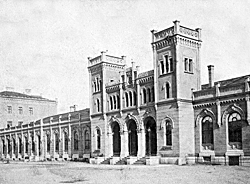Transport

There was major progress in the area of transport and city infrastructure. Linz evolved into one of the most significant transport hubs in the imperial monarchy. Transport along the Danube remained very important. The era of Emperor Franz Joseph, however, can be regarded as the age of railway par excellence: The first railway route on the continent, the horse-drawn railway to České Budějovice, opened in Linz in 1832.
After 1858, the construction of the Empress Elisabeth railway (Westbahn) connected Linz not only to the capital, but also to the international railway network. One of the consequences of industrialisation was the severing of the traditional unity of living space and work space. New neighbourhoods grew up. This resulted in larger flows of traffic in inner cities. The tram system came into being in the 1880s, at first to connect the railway stations. The construction of the Pöstlingberg railway in 1898, on the other hand, was considered more of a tourist attraction. Initially drawn by horses, the trams were powered by electricity after 1897. This made Linz one of the most innovative cities in the monarchy.